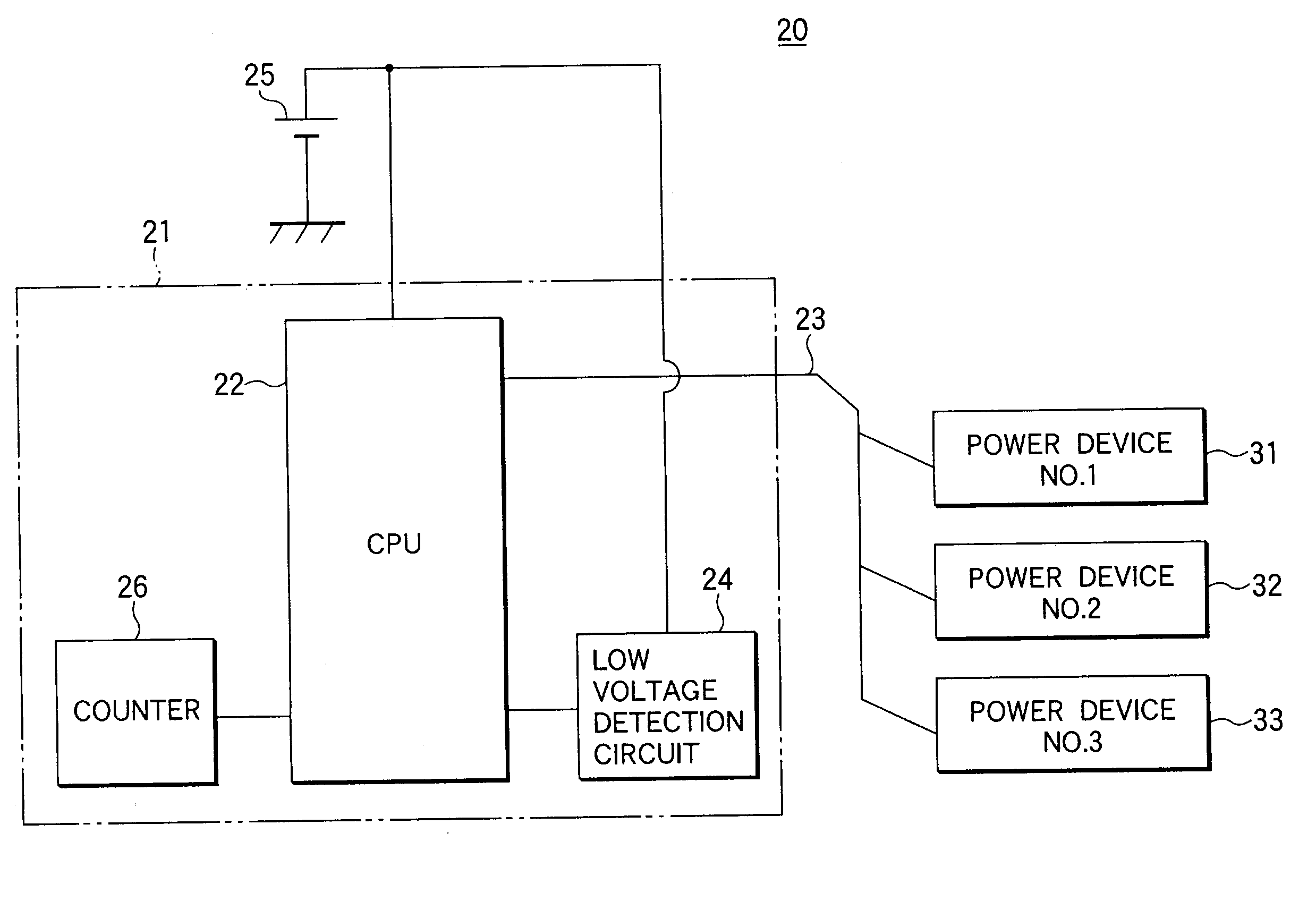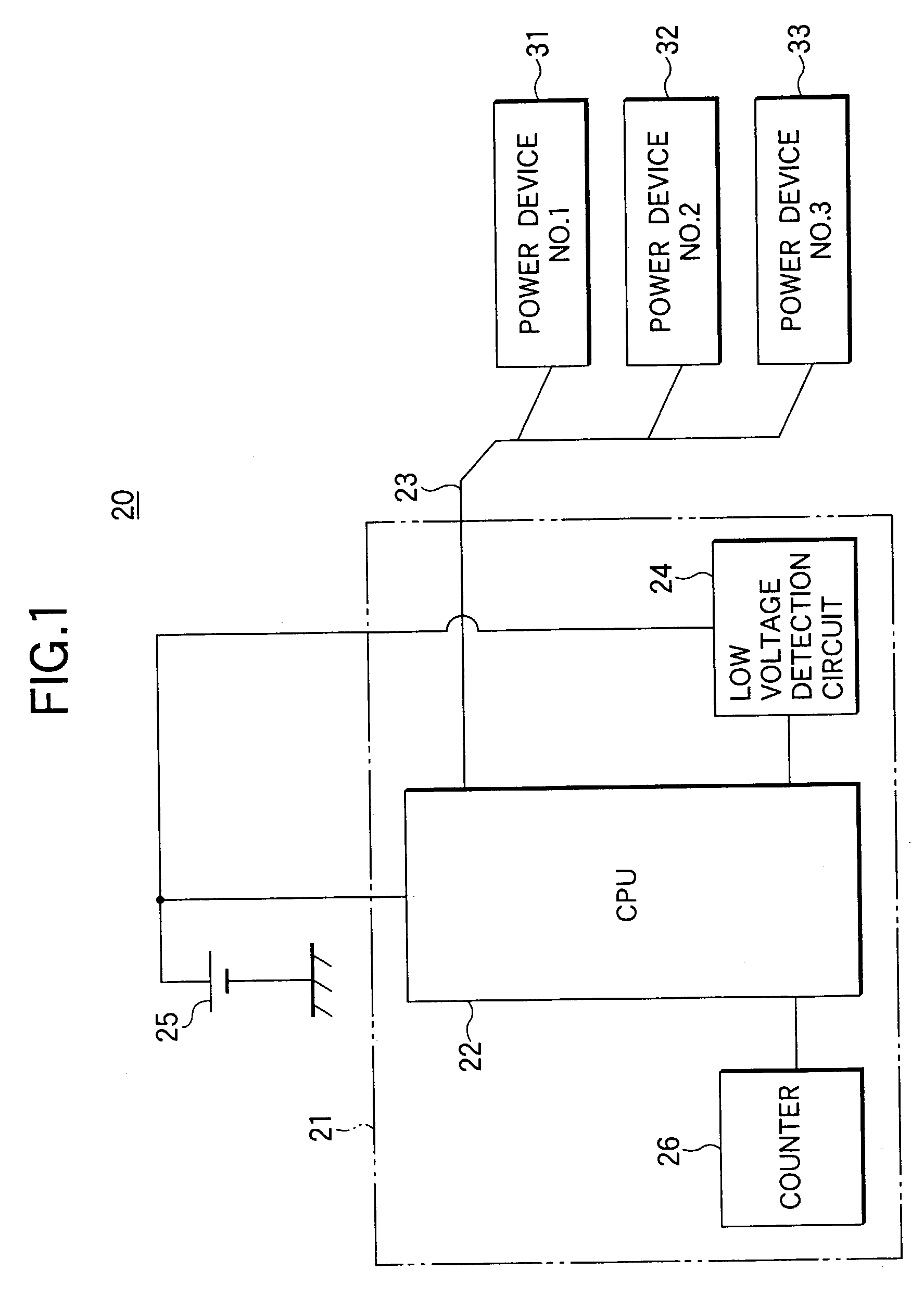Control apparatus and self-diagnostic method for electronic control system
a control apparatus and electronic control system technology, applied in the direction of testing/monitoring control systems, process and machine control, instruments, etc., can solve the problems of harm to the self-diagnostic function, and the inability to perform reliable operation. , to achieve the effect of high reliability
- Summary
- Abstract
- Description
- Claims
- Application Information
AI Technical Summary
Benefits of technology
Problems solved by technology
Method used
Image
Examples
first embodiment
[0033]FIG. 1 shows a schematic electrical configuration of an electronic control system 20 according to the invention. This electronic control system 20 is mounted in, for example, an automobile, and performs various control. A CPU 22 of a control apparatus 21 performs processing for the control according to a program preset in a ROM (not shown) According to a control result, data for driving various actuators is sent and received by serial communication through a communication line 23. Since the serial communication is used, a configuration of the communication line 23 can be simplified. In the control apparatus 21, a drop in power source voltage is detected as a disturbance factor having an influence on the control. The drop in power source voltage is detected by a low-voltage detection circuit 24. In this embodiment, when a drop in voltage supplied from a power source such as a battery 25 is detected, the number of data received by the serial communication is counted by a counter...
second embodiment
[0038]FIG. 5 shows a schematic electrical configuration of an electronic control system 40 according to the invention. In this embodiment, the same reference numerals are attached to parts corresponding to the embodiment of FIG. 1 and overlap description is omitted. In the electronic control system 40 of the embodiment, a CPU 42 of a control apparatus 41 operates according to a preset program. A timer 45 is provided instead of the counter 26 of FIG. 1. When a drop in power source voltage is detected in a low-voltage detection circuit 24, constant time is set in the timer 45 and for a period of this time, self-diagnostic data by serial communication is ignored.
[0039]As shown in FIG. 6, in a manner similar to the embodiment of FIG. 1, data indicating the self-diagnostic result from three power devices 31, 32, 33 is sequentially received as a serial signal. During such self-diagnosis, when a power source voltage drops abnormally and becomes a low-voltage detection level or less, the lo...
third embodiment
[0042]FIG. 8 shows a schematic electrical configuration of an electronic control system 50 according to the invention. In this embodiment, the same reference numerals are attached to parts corresponding to the embodiment of FIG. 1 or FIG. 5 and overlap description is omitted. In the electronic control system 50 of the embodiment, a CPU 52 of a control apparatus 51 operates according to a preset program. Two low-voltage detection circuits 54, 55 are provided instead of the low-voltage detection circuit 24 of FIGS. 1 and 5. It is constructed so that different low-voltage detection levels are set in the two low-voltage detection circuits 54, 55 and different constant time is set in a timer 45 when each of the detection circuits detects a drop in power source voltage.
[0043]As shown in FIG. 9, in a manner similar to the embodiments of FIGS. 1 and 5, data indicating the self-diagnostic result from three power devices 31, 32, 33 is sequentially received as a serial signal. During such self...
PUM
 Login to View More
Login to View More Abstract
Description
Claims
Application Information
 Login to View More
Login to View More - R&D
- Intellectual Property
- Life Sciences
- Materials
- Tech Scout
- Unparalleled Data Quality
- Higher Quality Content
- 60% Fewer Hallucinations
Browse by: Latest US Patents, China's latest patents, Technical Efficacy Thesaurus, Application Domain, Technology Topic, Popular Technical Reports.
© 2025 PatSnap. All rights reserved.Legal|Privacy policy|Modern Slavery Act Transparency Statement|Sitemap|About US| Contact US: help@patsnap.com



